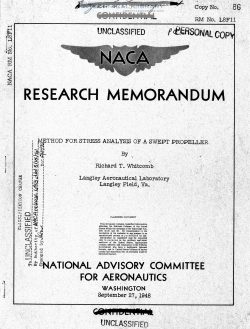naca-rm-L8F11
- Version
- 109 Downloads
- 8.30 MB File Size
- 1 File Count
- April 26, 2017 Create Date
- April 26, 2017 Last Updated
National Advisory Committee for Aeronautics, Research Memorandum - Method for Stress Analysis of a Swept Propeller

Results of an investigation by the free-fall method are presented
herein for a configuration having a body of revolution of fineness
ratio 12 and h5° sweptback wing mounted aft of the maximum diameter of
the body and. faired to the body by fillets. The fillets were designed
to provide large increases in the sweep of the leading edge and. the
line of maximum thickness as the wing root was approached.
Comparison of these results with those for the same configuration
without fillets shows that the addition of wing fillets increased the
total drag of the configuration by about 35 percent at Mach numbers
near 1.0 and. about 15 percent at Mach numbers near 1.2. Results
indicate that the fillets produced no appreciable change in the wing
and tail drags but produced a. large increase in body drag due to
interference.
The Flight Research Division of the Langley Aeronautical
laboratory is conducting an investigation ona series of wing-body
combinations by the free—fall method. The object of this investigation _
is to determine the transonic drag characteristics of promising transonic
and supersonic airplane arrangements. This series has so far been
limited to a. family of swept wings combined with identical body-tail
arrangements.
Previous results by this method and. other research have indicated
means for reducing the drag of airplane components at transonic speeds.
Tests of wing-body combinations are necessary, however, in order to
determine whether these results are appreciably altered by interference
effects between components. Results of a test of a #50 sweptback wing
mounted forward of the maximum diameter of a body of revolution of
fineness ratio 12 (reference l)ash6fid:‘+tha_t large interference effects
do exist at transomic speeds and, in this case, increase the drags of
both wing and body. Results of a further test, reported in reference 2,
showed that changing the location of the wing from a pesition ahead to .;
one behind the body maximum diameter reduced the body drag below that k-
of the body alone but did not appreciably change the drag of the wing.
| File | Action |
|---|---|
| naca-rm-L8F11 Method for Stress Analysis of a Swept Propeller.pdf | Download |

Comment On This Post